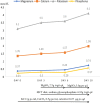Hypomagnesemia in intestinal lymphangiectasia: a case report and review of the literature
- PMID: 35570283
- PMCID: PMC9107688
- DOI: 10.1186/s12876-022-02318-6
Hypomagnesemia in intestinal lymphangiectasia: a case report and review of the literature
Abstract
Background: Intestinal lymphangiectasia (IL) is a rare disease characterized by dilation of lymphatic vessels and leakage of lymphatic fluids into the intestinal lumen, causing depletion of lymphocytes, protein, lipids, fat-soluble vitamins, and electrolytes. Hypomagnesemia can occur in IL patients but is seldom discussed.
Case presentation: A 30-year-old Tibetan woman who had chronic diarrhea, edema, tetany, and tingling was diagnosed with IL. Prominent hypomagnesemia was noticed. She was treated with a medium-chain triglyceride (MCT) diet and nutrient supplementation with satisfactory results. We also present a systematic review of hypomagnesemia in IL cases from the published literature.
Conclusions: Hypomagnesemia may be an overlooked complication of IL, thus monitoring serum magnesium concentrations in IL patients is crucial.
Keywords: Case report; Hypoproteinemia; Intestinal lymphangiectasia; Protein-losing enteropathy; Waldmann’s disease.
© 2022. The Author(s).
Conflict of interest statement
The authors declare that they have no competing interests.
Figures


References
Publication types
MeSH terms
Substances
Grants and funding
LinkOut - more resources
Full Text Sources

